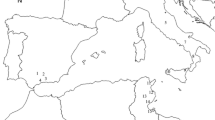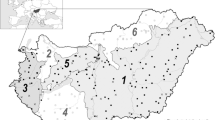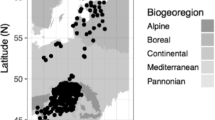Abstract
Phenological observations of the anthesic phases of olive flowering in a central Mediterranean area were recorded over a 9-year period. The aim of this research was to compare the flowering dates in relationship to the meteorological changes. Pollen emission from anthers was monitored by remote instrumentation placed directly in olive groves and phenological data regarding daily pollen concentrations (pollen/m3) were recorded using a pollen monitoring methodology. The rhythm of the phenological phases emerged as dependent on the meteorological trend of the spring forcing temperature. Generally, the phenomenon of pollen emission occurred progressively earlier prior to 2001, while in the following 5 years, the trend seemed to be inverted, showing a progressive delay of flowering. The spring quarterly mean temperature trends registered by GISS data in Europe confirmed the presence of diverse meteorological behavior during the study period, probably causing the biological divergences that were monitored. The principal result of the present contribution is to evidence the relativity of empirical investigations and observations considering different time intervals. This is due to the partial, brief series (9 years) of flowering dates which have to be considered as part of a longer series (26 years) in order to have a complete vision of the true phenomenon.






Similar content being viewed by others
References
Arnell NW (2003) Relative effects of multi-decadal climatic variability and changes in the mean and variability of climate due to global warming: future streamflows in Britain. J Hydrol 270:195–213
Bindi M, Howden M (2004) Challenges and opportunities for cropping systems in a changing climate, Proceedings of the 4th International Crop Science Congress Brisbane, Australia, 26 Sep-1 Oct 2004
Bindi M, Ferrini F, Miglietta F (1992) Climatic change and the shift in the cultivated area of olive trees. J Agr Mediter 22:41–44
Chen X, Hu B, Yu R (2005) Spatial and temporal variation of phenological growing season and climate change impacts in temperate eastern China. Global Change Biol 11(7):1118–1130
Chuine I, Cour P, Rousseau DD (1998) Fitting models predicting dates of flowering of temperate-zone trees using simulated annealing. Plant Cell Environ 21:455–466
Chuine I, Cour P, Rousseau DD (1999) Selecting models to predict the timing of flowering of temperate trees: implications for tree phenology modelling. Plant Cell Environ 22:1–13
Dixon AFG (2003) Climate change and phenological asynchrony. Ecol Entomol 28(3):380–381
Fornaciari M, Galan C, Mediavilla A, Dominguez E, Romano B (2000a) Aeropalynological and phenological study in two olive Mediterranean areas: Cordoba (Spagna) and Perugia (Italy). Plant Biosyst 134(2):199–204
Fornaciari M, Orlandi F, Romano B (2000b) Phenological and aeropalynological survey in an olive orchard in Umbria (Central Italy). Grana 39:246–251
Gagnon L, Comtois P (1992) Peut-on comparer les résultats de differents types de capteurs polliniques? Grana 31:125–130
Galan C, Vázquez L, García-Mozo H, Domínguez E (2004) Forecasting olive (Olea europaea L.) crop yield based on pollen emission. Field Crop Res 86(1):43–51
Hansen JE, Ruedy R, Sato MKI, Imhoff M, Lawrence W, Easterling D, Peterson T, Karl T (2001) A closer look at United States and global surface temperature change. J Geophys Res 106:23947–23963
Kramer K, Friend A, Leinonen I (1996) Modelling comparison to evaluate the importance of phenology and spring frost damage for the effects of climate change on growth of mixed temperate-zone deciduous forests. Climate Res 7:31–41
Maracchi G, Sirotenko O, Bindi M (2005) Impacts of present and future climate variability on agriculture and forestry in the temperate regions: Europe. Clim Change 70(1–2):117–135
Menzel A, Sparks THB, Estrella N et al (2006) European phenological response to climate change matches the warming pattern. Glob Change Biol 12(10):1969–1976
Ogden EC, Raynor GS, Hayes GV, Lewis DM, Haines JH (1974) Manual for sampling airborne pollen. Hafner Press, NY
Orlandi F, Ruga L, Romano B, Fornaciari M (2005a) Olive flowering as an indicator of local climatic changes. Theor Appl Climatol 81:169–176
Orlandi F, Ruga L, Romano B, Fornaciari M (2005b) An integrated use of aerobiological and phenological data to analyze flowering in olive groves. Grana 44:51–56
Orlandi F, Romano B, Fornaciari M (2005c) Relationship between flowering and Heat Units to analyze crop efficiency of olive cultivars located in southern Italy. Hortscience 40(1):64–68
Osborne CP, Chuine I, Viner D, Woodward FI (2000) Olive phenology as a sensitive indicator of future climatic warming in the Mediterranean. Plant Cell Environ 23:701–710
Rahmstorf S, Ganopolski A (1999) Long-term global warming scenarios computed with an efficient coupled climate model. Clim Change 43(2):353–367
Réaumur De RAF (1730) Regles pour costruire des thermomètres dont les degréssoient comparables. Mém Acàd des Sci, Paris, pp 452–507
Réaumur RAF De (1738) Observations du thermometre, faites à Paris pendant l’année M. DCCXXXV. Histoire de l’Académie Royale des Sciences, Année M. DCCXXXV, Avec les Mémoires de Mathématique & de Physique, pour la même Année: 545–576
Rötzer T, Chmielewski FM (2001) Phenological maps of Europe. Climate Res 18(3):249–257
Schaber J (2001) Regional phenology in Germany between 1880 and 1999: Trends and causes. Proc. International Conference: The times they are a-changing, Climate change, phenological responses and their consequences for biodiversity, agriculture, forestry, and human health. December 2001. Wageningen, the Netherlands, p 33
Schwartz MD (1999) Advancing to full bloom: planning phenological research for the 21st century. Int J Biometeorol 42:113–118
Seager R, Battisti DS, Yin J, Gordon N, Naik N, Clement AC, Cane MA (2002) Is the Gulf Stream responsible for Europe’s mild winters? Q J Roy Met Soc 128:2563–2586
Tomas C, Candau P, Gonzalez Minero FJ (1997) A comparative study of atmospheric pollen concentrations collected with Burkard and Cour samplers, Seville (Spain), 1992–1994. Grana 36:122–128
UN-IPCC - United Nations Intergovernmental Panel on Climate Change (2001) Third assessment report. Cambridge University Press, Cambridge, p 881
Van Vliet AJH, De Groot RS (2001) The European Phenology Network. Proc. International Conference: The times they are a-changin. Climate change, phenological responses and their consequences for biodiversity, agriculture, forestry, and human health. December 2001. Wageningen, The Netherlands, pp 11–13
Zalom, FJ, Goodell, PB, Wilson, LT, Barnett, WW & Bentley, WJ (1983) Degree-days: the calculation and use of heat units in pest management. DANR Leaflet 21373, University of California
Author information
Authors and Affiliations
Corresponding author
Rights and permissions
About this article
Cite this article
Orlandi, F., Sgromo, C., Bonofiglio, T. et al. A comparison among olive flowering trends in different Mediterranean areas (south-central Italy) in relation to meteorological variations. Theor Appl Climatol 97, 339–347 (2009). https://doi.org/10.1007/s00704-008-0079-4
Received:
Accepted:
Published:
Issue Date:
DOI: https://doi.org/10.1007/s00704-008-0079-4




